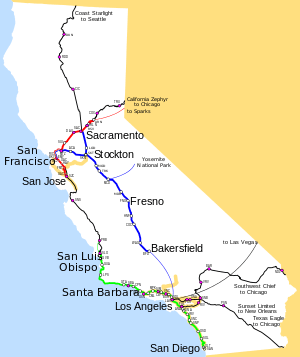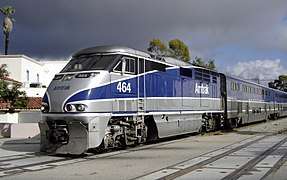Amtrak California
Amtrak California (reporting mark CDTX) is a brand name used by the California Department of Transportation (Caltrans) Division of Rail on three state-supported Amtrak rail routes within the US State of California, the Capitol Corridor, the Pacific Surfliner, and the San Joaquins.[1] It also includes an extensive network of Thruway Motorcoach bus connections, operated by private companies under contract. The three lines shared the use of "Amtrak California" branded Thruway buses and trainsets.
 | |||
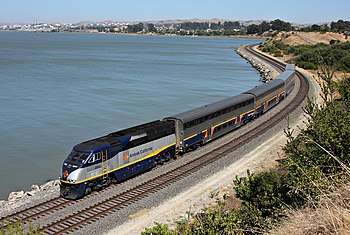 Amtrak California train in Pinole, California, 2011 | |||
| Overview | |||
|---|---|---|---|
| Owner | Caltrans Division of Rail | ||
| Locale | California | ||
| Transit type | Inter-city rail | ||
| Number of lines | 3 | ||
| Headquarters | Sacramento, California | ||
| Website | Amtrak California | ||
| Operation | |||
| Began operation | 1976 | ||
| Operator(s) | Amtrak | ||
| Reporting marks | CDTX | ||
| Technical | |||
| Track gauge | 4 ft 8 1⁄2 in (1,435 mm) | ||
| |||
History
The National Railroad Passenger Corporation (Amtrak) assumed operation of almost all intercity passenger rail in the United States in 1971. Service in California, as in most of the United States, was basic and infrequent. In 1976 California began providing financial assistance to Amtrak.[1] At the same time, Caltrans Division of Rail was formed to oversee state-financed rail operations and the brand Amtrak California started appearing on state-supported routes.
In 1990, California passed Propositions 108 and 116, providing $3 billion for transportation projects ($5.9 billion after inflation), with a large portion going to rail service.[2] As a result, new locomotives and passenger cars were purchased by the state, and existing inter-city routes expanded. A more distinct image for Amtrak California, such as painting locomotives and passenger cars in "California Color" of blue and yellow, was established with the arrival of new rolling stock.
In 1998, while still funded by the state, the management of the Capitol Corridor was transferred to the Capitol Corridor Joint Powers Authority (CCJPA), formed by local jurisdictions of the line serves. In 2015 the management of the San Joaquin and the Pacific Surfliner were similarly transferred to the San Joaquin Joint Powers Authority (SJJPA) and the Los Angeles-San Diego-San Luis Obispo Rail Corridor Agency (LOSSAN), respectively.[3] As a result, the "Amtrak California" brand became less prominent in the websites and marketing materials.
Amtrak California | ||||||||||||||||||||||||||||||||||||||||||||||||||||||||||||||||||||||||||||||||||||||||||||||||||||||||||||||||||||||||||||||||||||||||||||||||||||||||||||||||||||||||||||||||||||||||||||||||||||||||||||||||||||||||||||||||||||||||||||||||||||||||||||||||||||||||||||||||||||||||||||||||||||||||||||||||||||||||||||||||||||||||||||||||||||||||||||||||||||||||||||||||||||||||||||||||||||||||||||||||||||
|---|---|---|---|---|---|---|---|---|---|---|---|---|---|---|---|---|---|---|---|---|---|---|---|---|---|---|---|---|---|---|---|---|---|---|---|---|---|---|---|---|---|---|---|---|---|---|---|---|---|---|---|---|---|---|---|---|---|---|---|---|---|---|---|---|---|---|---|---|---|---|---|---|---|---|---|---|---|---|---|---|---|---|---|---|---|---|---|---|---|---|---|---|---|---|---|---|---|---|---|---|---|---|---|---|---|---|---|---|---|---|---|---|---|---|---|---|---|---|---|---|---|---|---|---|---|---|---|---|---|---|---|---|---|---|---|---|---|---|---|---|---|---|---|---|---|---|---|---|---|---|---|---|---|---|---|---|---|---|---|---|---|---|---|---|---|---|---|---|---|---|---|---|---|---|---|---|---|---|---|---|---|---|---|---|---|---|---|---|---|---|---|---|---|---|---|---|---|---|---|---|---|---|---|---|---|---|---|---|---|---|---|---|---|---|---|---|---|---|---|---|---|---|---|---|---|---|---|---|---|---|---|---|---|---|---|---|---|---|---|---|---|---|---|---|---|---|---|---|---|---|---|---|---|---|---|---|---|---|---|---|---|---|---|---|---|---|---|---|---|---|---|---|---|---|---|---|---|---|---|---|---|---|---|---|---|---|---|---|---|---|---|---|---|---|---|---|---|---|---|---|---|---|---|---|---|---|---|---|---|---|---|---|---|---|---|---|---|---|---|---|---|---|---|---|---|---|---|---|---|---|---|---|---|---|---|---|---|---|---|---|---|---|---|---|---|---|---|---|---|---|---|---|---|---|---|---|---|---|---|---|---|---|---|---|---|---|---|---|---|---|---|---|---|---|---|---|---|---|---|---|---|---|---|---|---|---|---|---|---|---|---|---|---|---|---|---|---|---|---|---|---|---|---|---|
| ||||||||||||||||||||||||||||||||||||||||||||||||||||||||||||||||||||||||||||||||||||||||||||||||||||||||||||||||||||||||||||||||||||||||||||||||||||||||||||||||||||||||||||||||||||||||||||||||||||||||||||||||||||||||||||||||||||||||||||||||||||||||||||||||||||||||||||||||||||||||||||||||||||||||||||||||||||||||||||||||||||||||||||||||||||||||||||||||||||||||||||||||||||||||||||||||||||||||||||||||||||
| ||||||||||||||||||||||||||||||||||||||||||||||||||||||||||||||||||||||||||||||||||||||||||||||||||||||||||||||||||||||||||||||||||||||||||||||||||||||||||||||||||||||||||||||||||||||||||||||||||||||||||||||||||||||||||||||||||||||||||||||||||||||||||||||||||||||||||||||||||||||||||||||||||||||||||||||||||||||||||||||||||||||||||||||||||||||||||||||||||||||||||||||||||||||||||||||||||||||||||||||||||||
As of 2017 Caltrans is studying Amtrak service to the Coachella Valley.
Rolling Stock
Locomotives

Amtrak California operates a fleet of EMD F59PHI, GE Dash 8-32BWH and Siemens Charger locomotives that are used on San Joaquin and Capitol Corridor trains. These locomotives are owned by Caltrans and carry the CDTX reporting marks.[4]
The Pacific Surfliner trains also used a dedicated fleet of 15 EMD F59PHI locomotives that are painted to match the livery of the "Surfliner" passenger cars, but they were Amtrak owned instead. These locomotives were sold to Metra in early 2018 and subsequently replaced by the Charger locomotives. The last Amtrak-owned F59PHI left for Chicago on March 1, 2019.
Locomotives from Amtrak's national fleet such as P42DC are often used as substitutes when the Amtrak California dedicated fleet of locomotives undergoes maintenance.
Twenty-two additional locomotives built by Siemens will join Amtrak California's locomotive fleet starting from 2017. These locomotives, named Charger, were parts of a multi-state order funded by a combination of federal and state money. Illinois Department of Transportation, acting as the leading agency, awarded the order to Siemens on December 18, 2013.[5][6] Caltrans ordered the first six with the initial order in 2013, then exercised the option to buy 14 more locomotives in 2015 to replace Amtrak-owned locomotives currently used on Pacific Surfliner.[7] Two additional locomotives were ordered in 2016.
Passenger Cars
California Car / Surfliner bi-level trainsets
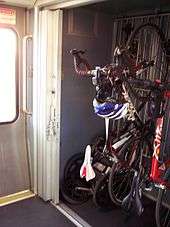
Amtrak California's routes typically use bi-level, high-capacity passenger cars, dubbed the Surfliner and California Car. All of the California Cars are owned by the California Department of Transportation (Caltrans). Most of the Surfliner cars are owned by Amtrak with some owned by Caltrans.
The design of the cars is based on Amtrak's Superliner bi-level passenger cars, but several changes were made to the design to make the car more suitable for corridor services with frequent stops. One very important difference is that the Surfliner and California Car have two sets of automatic doors on each side instead of only one manually operated door on the Superliners, which speeds up boarding and alighting considerably.[4] Additionally, Surfliner and California Car coaches are equipped with higher-density seating and bicycle racks to permit transport of unboxed bicycles.
Consists on the San Joaquin, Capitol Corridor, and Pacific Surfliner routes usually include between four and six cars, with one locomotive and a cab control car on the rear end.
Superliner I rebuilds
In 2007, Amtrak California paid for the repair of seven wreck-damaged Superliner Coaches owned by Amtrak in exchange for a six-year lease, intended to quickly add capacity on busy Capitol Corridor and San Joaquin trains. Four of the cars have been painted to match the "California car" livery and three have been painted to match the "Surfliner" livery. Each car also has the current Amtrak logo on the middle left side of each car.
Superliner I/II coaches from Amtrak's national fleet are used on some consists due to shortages of inter-city "Surfliner" & "California cars."
Comet car single-level trainsets
Increasing ridership on the San Joaquin led Amtrak California to purchase 14 Comet IB rail cars from NJ Transit in 2008 for $75,000 per car. Caltrans paid approximately $20 million to have these former commuter cars refurbished and reconfigured to serve as intercity coaches at Amtrak's Beech Grove Shops.[8]
Caltrans has also paid to lease and refurbish 3 Horizon dinettes (used as café cars) and 3 Non-Powered Control Units (old F40PH locomotives converted to serve as a cab/baggage car).[8]
New bi-level cars
As the leading agency of a joint purchase agreement with the Midwest Coalition consisted of Illinois, Michigan, and Missouri, Caltrans awarded the 130 bilevel passenger car order to Nippon Sharyo on November 6, 2012, to be built at Nippon Sharyo's new factory at Rochelle, Illinois, of which 42 would have gone to California[9] The design of new bilevel cars would have been based on existing California Cars with heavy involvement from Caltrans. However, Siemens was later selected to build new single level train cars after a car failed a compression test.
Livery
Amtrak California utilizes a livery and logo that is different from the standard Amtrak colors. All state-contracted Thruway Motorcoach and state-owned locomotives and passenger cars, with the exception of equipment used on the Pacific Surfliner route, are painted in the "California Colors" of blue and yellow. Each permanently assigned passenger car is named after a geographical feature of California.
The Capitol Corridor and San Joaquin trains are the two routes most identified with the Amtrak California image, since they extensively use "California Colored" equipment. The other state-supported rail route, the Pacific Surfliner, uses a unique blue and silver paint scheme that is different from the other Amtrak California-branded trains.
The NPCUs that operate on the Capitol Corridor and San Joaquin are painted differently from the locomotives, as they are painted in the old Caltrain locomotive livery, with an Amtrak California and Caltrans logo on the sides. The single level cars, both the Comet cars and the Horizon dinettes, have three stripes closest to the boarding doors, orange, blue and green, which resemble the NJ Transit livery that was previously used on the Comet cars.
Routes
Pacific Surfliner
The Pacific Surfliner is a major commuting route in Southern California. The entire length of the line runs from San Luis Obispo in the north, down to San Diego in the south. It hugs the California coast for most of the route–as close as 100 feet from the Pacific in some areas–providing a stunning backdrop. Most trains on the Pacific Surfliner route only travel a portion of the whole route. With 2.7 million passengers in fiscal year 2013, this is Amtrak's most heavily travelled service outside the Northeast Corridor.[10] This is the busiest of the three Amtrak California routes in terms of ridership; in fact it is the third-busiest Amtrak route nationwide, behind only the Northeast Regional and the Acela Express.[11] It is also the oldest; service along this route dates to 1939, with the Santa Fe's San Diegan. Amtrak extended up the Central Coast in the 1980s and 1990s, ultimately renaming it the Pacific Surfliner in 2000.
San Joaquin
The San Joaquin operates 14 trains (7 in each direction) each day between Bakersfield and Stockton. From Stockton, five trains from Bakersfield continue west to Oakland, while two trains proceed north to the state capital of Sacramento. Central Valley communities served include Fresno, Corcoran, Hanford, Lodi, Madera, Merced, Modesto, Turlock/Denair and Wasco. Delta/Bay communities of Antioch, Martinez, and Richmond are also served by the San Joaquin. Los Angeles is not served on this route due to the bottleneck of the Tehachapi Pass line, where the Union Pacific prohibits passenger train use due to freight traffic along the world's busiest single-track railway. (On rare occasions Amtrak trains use this as a detour if their railway tracks are being repaired.) The San Joaquin has operated since 1974.
Capitol Corridor
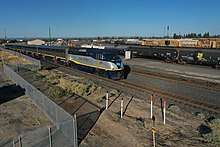
The Capitol Corridor route, operating since 1991, runs north from San Jose through the East Bay to Oakland and Richmond, then east through the Delta communities of Martinez and Suisun City, and the Sacramento Valley cities of Davis and Sacramento. One Capitol Corridor train per day continues east of Sacramento during the afternoon commute to the small Sierra Nevada town of Auburn, returning in the morning. It is the fourth-busiest Amtrak route nationwide.
See also
- List of Amtrak stations in California
- List of San Francisco Bay Area trains
- Other former state-supported rail services:
- CalTrain – a short-lived service in Southern California, later re-established under local control
- Orange County Commuter – commuter service conveyed to local control in 1994
- Spirit of California – sleeper-service which ran between Los Angeles and Sacramento via Oakland from 1981-1983
References
- "About Amtrak California". State of California Department of Transportation. 2013. Archived from the original on January 2, 2014. Retrieved December 22, 2013.
- Prop. 108: Passenger Rail And Clean Air Bond Act of 1990; California Streets and Highways Code, Division 3, Chapter 17
- Sheehan, Tim (June 26, 2015). "Valley agency takes control of Amtrak San Joaquin trains". Sacramento Bee. Retrieved November 15, 2016.
- All Aboard – Amtrak California Archived February 5, 2007, at the Wayback Machine
- "Archived copy" (PDF). Archived from the original (PDF) on March 18, 2014. Retrieved March 18, 2014.CS1 maint: archived copy as title (link)
- Tita, Bob (February 27, 2014). "Caterpillar Loses High-Speed Train Contract". The Wall Street Journal. Retrieved May 4, 2015.
- John Palminteri (November 10, 2015). "Cleaner Train Engines Coming to the Central Coast". KEYT-KCOY-KKFX.
- "San Joaquin Rolling Stock Presentation" (PDF). San Joaquin Joint Powers Authority/Caltrans. pp. 35–42. Retrieved June 30, 2013.
- Nippon Sharyo and Sumitomo Corporation receive the Contract Award for 130 Bi-Level Passenger Cars from Caltrans and IDOT Archived March 16, 2014, at the Wayback Machine
- "Amtrak Sets Ridership Record And Moves The Nation's Economy Forward – America's Railroad helps communities grow and prosper" (PDF) (Press release). Amtrak. October 14, 2013. Retrieved September 3, 2014.
- "State of California FY2017 Fact Sheet" (PDF). Amtrak. November 2017. Retrieved June 6, 2018.
External links
- Amtrak California
- Amtrak (national)
- The Rail Passenger Association of California (RailPAC) a statewide membership organization working for the expansion and improvement of rail passenger service within the states of California and Nevada.
